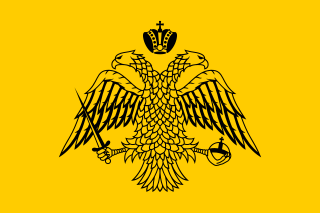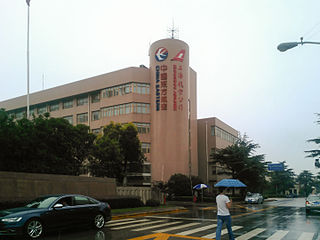
Anatolia, also known as Asia Minor, Asian Turkey, the Anatolian peninsula or the Anatolian plateau, is a large peninsula in West Asia and the westernmost protrusion of the Asian continent. It makes up the majority of modern-day Turkey. The region is bounded by the Black Sea to the north, the Mediterranean Sea to the south, the Armenian Highlands to the east and the Aegean Sea to the west. The Sea of Marmara forms a connection between the Black and Aegean seas through the Bosphorus and Dardanelles straits and separates Anatolia from Thrace on the Balkan peninsula of Europe.

The Eastern Orthodox Church, officially the Orthodox Catholic Church, is the second-largest Christian church, with approximately 260 million baptised members. It operates as a communion of autocephalous churches, each governed by its bishops in local synods. Roughly half of Eastern Orthodox Christians live in Russia. The church has no central doctrinal or governmental authority analogous to the bishop of Rome, but the ecumenical patriarch of Constantinople is recognised by all as primus inter pares of the bishops. As one of the oldest surviving religious institutions in the world, the Eastern Orthodox Church has played a prominent role in the history and culture of Eastern and Southeastern Europe, the Caucasus, and the Near East.

The Levant is an approximate historical geographical term referring to a large area in the Eastern Mediterranean region of Western Asia. In its narrowest sense, it is equivalent to the historical region of Syria, which included present-day Syria, Lebanon, Jordan, Israel, Palestine and most of Turkey south-east of the middle Euphrates. In its widest historical sense, the Levant included all of the Eastern Mediterranean with its islands; that is, it included all of the countries along the Eastern Mediterranean shores, extending from Greece to Cyrenaica in eastern Libya.

The Mediterranean Sea is a sea connected to the Atlantic Ocean, surrounded by the Mediterranean Basin and almost completely enclosed by land: on the north by Southern Europe and Anatolia, on the south by North Africa and on the east by the Levant. Although the sea is sometimes considered a part of the Atlantic Ocean, it is usually referred to as a separate body of water. Geological evidence indicates that around 5.9 million years ago, the Mediterranean was cut off from the Atlantic and was partly or completely desiccated over a period of some 600,000 years before being refilled by the Zanclean flood about 5.3 million years ago.

The Middle East is a transcontinental region which includes Western Asia and all of Egypt. The term has come into wider usage as a replacement of the term Near East beginning in the early 20th century. The broader concept of the "Greater Middle East" also adds the Maghreb, Sudan, Djibouti, Somalia, Afghanistan, Pakistan, and sometimes even Central Asia and Transcaucasia into the region. The term "Middle East" has led to some confusion over its changing definitions.

Western Europe is the region comprising the western part of Europe. Though the term Western Europe is commonly used, there is no consensus on which countries comprise it.

Eastern Europe is the eastern part of the European continent. There is no consistent definition of the precise area it covers, partly because the term has a wide range of geopolitical, geographical, cultural, and socioeconomic connotations. There are "almost as many definitions of Eastern Europe as there are scholars of the region". A related United Nations paper adds that "every assessment of spatial identities is essentially a social and cultural construct". One definition describes Eastern Europe as a cultural entity: the region lying in Europe with the main characteristics consisting of Greek, Byzantine, Eastern Orthodox, Russian, and some Ottoman cultural influences. Another definition was created during the Cold War and used more or less synonymously with the term Eastern Bloc. A similar definition names the formerly communist European states outside the Soviet Union as Eastern Europe. Most historians and social scientists view such definitions as outdated or relegated, but they are still sometimes used for statistical purposes.

Eastern Christianity comprises church families that developed - outside the Occident - from the original cradle of Christianity in Asia, with major bodies including the Eastern Orthodox Church, the Oriental Orthodox churches, the Eastern Catholic churches, Protestant Eastern Christian Churches who are Protestant in theology but Eastern Christian in cultural practice, and the denominations descended from the Church of the East.
Eastern Air Lines, also colloquially known as Eastern, was a major American airline from 1926 to 1991. Before its dissolution, it was headquartered at Miami International Airport in an unincorporated area of Miami-Dade County, Florida.

The Eastern Bloc, also known as the Communist Bloc, the Socialist Bloc and the Soviet Bloc, is the group of communist states of Central and Eastern Europe, East Asia, and Southeast Asia under the hegemony of the Soviet Union (USSR) that existed during the Cold War (1947–1991) in opposition to the capitalist Western Bloc. In Western Europe, the term Eastern Bloc generally referred to the USSR and its satellite states in the Comecon ; in Asia, the Soviet Bloc comprised the Mongolian People's Republic, the Socialist Republic of Vietnam, the Lao People's Democratic Republic and the People's Republic of Kampuchea, the Democratic People's Republic of Korea, and the People's Republic of China. In the Americas, the Communist Bloc included the Caribbean Republic of Cuba since 1961 and Grenada.

The Eastern Catholic Churches or Oriental Catholic Churches, also called the Eastern-rite Catholic Churches, or simply the Eastern Churches and in some historical cases referred to pejoratively as Uniates, are twenty-three Eastern Christian sui iuris (autonomous) particular churches of the Catholic Church, in full communion with the pope in Rome. They are united with one another and with the Latin or Roman Church. In particular, they recognize the central role of the Bishop of Rome within the College of Bishops and his infallibility when speaking ex cathedra. The majority of the Eastern Catholic Churches are groups from the Eastern Orthodox Church, the Oriental Orthodox churches, and the historic Church of the East that have returned to communion with the Bishop of Rome due to extenuating political and cultural circumstances influencing the churches' relations. As such the five liturgical traditions of the twenty-three Eastern Catholic Churches, including the Alexandrian Rite, the Armenian Rite, the Byzantine Rite, the East Syriac Rite, and the West Syriac Rite, are shared with other Eastern Christian churches. Consequently, the Catholic Church consists of six liturgical rites; including the aforementioned five liturgical traditions of the Eastern Catholic Churches along with the Latin liturgical rites of the Latin Church.

The name Greek Orthodox Church, or Greek Orthodoxy, is a term referring to the body of several Churches within the larger communion of Eastern Orthodox Christianity, whose liturgy is or was traditionally conducted in Koine Greek, the original language of the Septuagint and the New Testament, and whose history, traditions, and theology are rooted in the early Church Fathers and the culture of the Byzantine Empire. Greek Orthodox Christianity has also traditionally placed heavy emphasis and awarded high prestige to traditions of Eastern Orthodox monasticism and asceticism, with origins in Early Christianity in the Near East and in Byzantine Anatolia.
A Christian denomination is a distinct religious body within Christianity, identified by traits such as a name, organization, leadership and doctrine. The Roman Catholic Church, Eastern Orthodox Church, and Oriental Orthodox Churches, meaning the large majority, all self-describe as churches, whereas many Protestant denominations self-describe as congregations or fellowships. Divisions between one group and another are defined by authority and doctrine; issues such as the nature of Jesus, the authority of apostolic succession, ecclesiology, eschatology, and papal primacy may separate one denomination from another. Groups of denominations—often sharing broadly similar beliefs, practices, and historical ties—are sometimes known as "branches of Christianity". These branches differ in many ways, especially through differences in practices and belief.

The North American Central Time Zone (CT) is a time zone in parts of Canada, the United States, Mexico, Central America, some Caribbean Islands, and part of the Eastern Pacific Ocean.

The Eastern Time Zone (ET) is a time zone encompassing part or all of 22 states in the eastern part of the contiguous United States, parts of eastern Canada, the state of Quintana Roo in Mexico, Panama in Central America, and Colombia, mainland Ecuador, Peru, and a small portion of westernmost Brazil in South America, along with certain Caribbean and Atlantic islands. Places that use Eastern Standard Time (EST) when observing standard time (autumn/winter) are five hours behind Coordinated Universal Time (UTC−05:00).

China Eastern Airlines Corporation Limited, also known as China Eastern, is an airline headquartered in the China Eastern Airlines Building, on the grounds of Shanghai Hongqiao International Airport in Changning District, Shanghai. It is a major Chinese airline operating international, domestic and regional routes. Its main hubs are at Shanghai Pudong International Airport and Shanghai Hongqiao International Airport.

UTC−05:00 is an identifier for a time offset from UTC of −05:00. In North America, it is observed in the Eastern Time Zone during standard time, and in the Central Time Zone during the other eight months. The western Caribbean uses it year round.
New York most commonly refers to:

A crow is a bird of the genus Corvus, or more broadly a synonym for all of Corvus. The term "crow" is used as part of the common name of many species. Species with the word "crow" in their common name include:

UTC−04:00 is an identifier for a time offset from UTC of −04:00. It is observed in the Eastern Time Zone during the warm months of daylight saving time, as Eastern Daylight Time. The Atlantic Time Zone observes it during standard time . It is observed all year in the Eastern Caribbean.

















